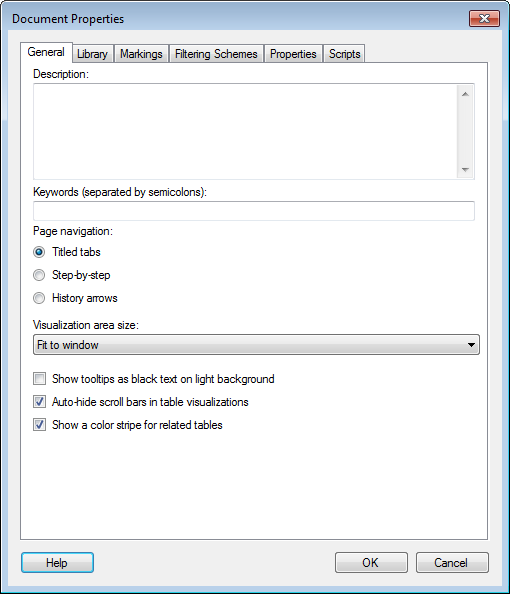
The General tab of the Document Properties dialog is where you can add a description of the analysis and keywords to describe the content of the analysis. You can also specify what kind of page navigation to use in the analysis.
To reach the Document Properties dialog:
Select Edit > Document Properties.
Click on the General tab.
General Tab

Option |
Description |
Description |
An optional description of the analysis. The description could contain detailed information about the analysis enabling quick overviews. |
Keywords
(separated by semicolons) |
Keywords specific to the content of the analysis. Keywords are separated by semicolons. This means that if you write "sales representatives; cost" it will be interpreted as two keywords, "sales representatives" and "cost". Keywords are used to enhance organization and search capabilities. |
Page
navigation |
Determines which type of page navigation to use in the analysis. See Pages to learn more about the different navigation modes. You can change the default page navigation for all new analyses on the Document page in the Tools > Options dialog. |
Titled
tabs |
Shows all pages as separate tabs, which can be dragged and dropped to change the order of the pages. See also What is a Guided Analysis? |
Step-by-step |
Shows all pages as numbered links to support a specific flow throughout the analysis. See also What is a Guided Analysis? |
History arrows |
Hides the page navigation, except for the page history arrows. Use this mode if you want to create your own flow throughout the analysis, by adding actions directly on the pages. See also What is a Guided Analysis? |
Visualization
area size |
Determines the size of the area where visualizations are shown. Use Fit to window to automatically resize the visualization area after the current size of the Spotfire window. If you are preparing an analysis for a different platform than the one you are currently using, you may want to lock the visualization area to a specific size. For example, use iPad Landscape or iPad Portrait to reduce the available visualization area size for each page and optimize the analysis for that platform. An administrator can define other preset sizes using Administration Manager under Preferences > [Group] > Application > ApplicationPreferences > Fixed Visualization Area Sizes. Tip: When Custom size... is selected the current visualization area size is shown by default, if no other custom sizes have been used previously. Tip: The visualization area size is persisted in bookmarks so a set of bookmarks with different layouts can be used to switch between different area sizes. |
Show tooltips as black text on light background |
Select the check box if you want to display tooltips as black text on a light background rather than the default white text on black background. |
Auto-hide
scroll bars in table visualizations |
Select the check box if you want scroll bars in tabular visualizations to be displayed only on mouse-over. If you clear the check box, then scroll bars will always be shown in tabular visualizations where some of the content does not fit on screen. |
Show
a color stripe for related tables |
If you want to keep track of which data tables are related, select this check box. A common colored stripe will appear in the title bars of the visualizations based on related data tables. Also filters in the Filters panel from related data tables (which may affect each other when they are manipulated) are indicated with this color. |
See also:
Details on Document Properties - Library
Details on Document Properties - Markings
Details on Document Properties - Filtering Schemes
Details on Document Properties - Properties
Details on Document Properties – Scripts
How to Edit Document Properties